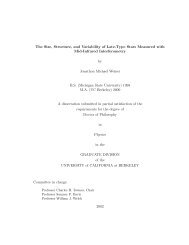Problem #1 [Structure Formation I: Radiation Era]
Problem #1 [Structure Formation I: Radiation Era]
Problem #1 [Structure Formation I: Radiation Era]
Create successful ePaper yourself
Turn your PDF publications into a flip-book with our unique Google optimized e-Paper software.
(b). How does the growth of pertubations depend on Ω 0,m ?<br />
We can see that the growth of the fluctuations depend very strongly with Ω 0,m .<br />
For Ω 0,m = 0.01 We can see that the growth of structure decreases very rapidly as z → 0, where<br />
the slope of the curve aproaches 0 today. This seems very unlikely, due to the fact that we<br />
live in a universe filled with galaxies.<br />
For Ω 0,m = 0.10 we can see that increasing the mass density by one order of magnitude, causes<br />
the growth of structure to continue as z → 0 and we can see that the more matter you put<br />
into the universe the longer the growth of the fluctuations (over densities).<br />
For Ω 0,m = 0.30 we can see that this is very similar to the last curve, except that we can see<br />
now that it is approaching δ + m ∝ a.<br />
For Ω 0,m = 1.00 we can see that the growth of structure is a constant<br />
If the four models you plotted all produce the same level of pertubations today (that matches<br />
the observed number density of galaxies, for example), how do you expect (qualitatively) the<br />
amount of structures to differ in the four models at redshift z = 3?<br />
To try to understand this question we can make the same plot as before, except that we must<br />
normalize all the models to a(θ) = 1.00<br />
1.000<br />
δ m<br />
+<br />
vs a<br />
0.100<br />
δ m<br />
+<br />
(θ)<br />
0.010<br />
Ω m<br />
0.001<br />
0.001 0.010 0.100 1.000<br />
a(θ)<br />
thus from this plot we can see that at z = 3 the pertubations must have grown a lot faster in<br />
the past for Ω 0,m < 1, with increasing growth as Ω 0,m → 0. This must have happened in order<br />
for us to see the structures we see today.<br />
4


![Problem #1 [Structure Formation I: Radiation Era]](https://img.yumpu.com/37147371/4/500x640/problem-1-structure-formation-i-radiation-era.jpg)













